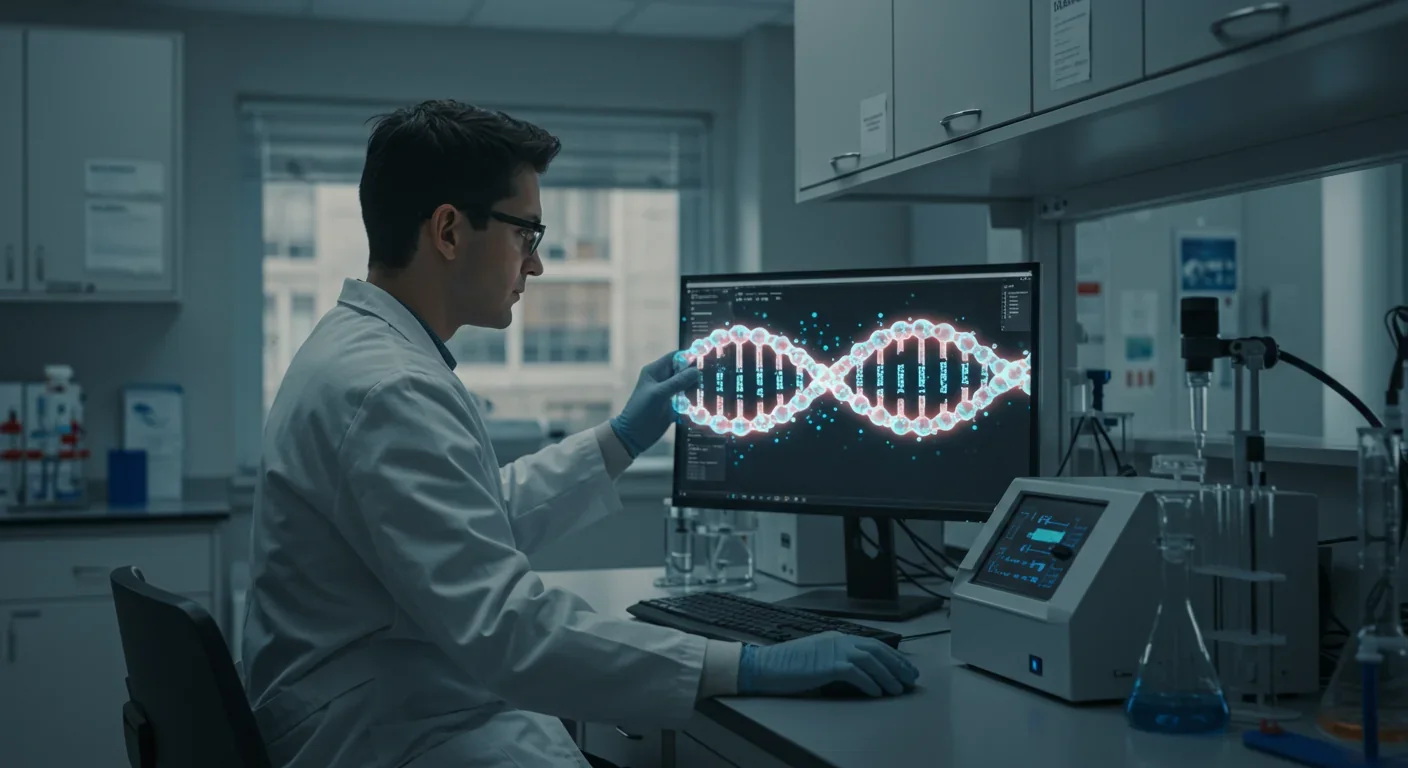Epigenetic Clocks Predict Disease 30 Years Early

TL;DR: CRISPR 2.0 technologies like prime and base editing have achieved error rates as low as 1 in 543, enabling FDA-approved cures for sickle cell and beta thalassemia. While costs remain high at $2 million per treatment, the one-time cure model promises to transform medicine for hundreds of inherited diseases.

By 2030, scientists predict that hundreds of inherited diseases once considered death sentences will become treatable with a simple gene edit. We're not talking about distant theoretical possibilities. Right now, patients with sickle cell disease are walking out of hospitals cured. People with beta thalassemia are living without blood transfusions for the first time in their lives. This isn't science fiction anymore, it's happening in clinics across America and Europe, and it's powered by what researchers call CRISPR 2.0.
The original CRISPR system, discovered just over a decade ago, was revolutionary but crude. Think of it as using molecular scissors to cut DNA, then hoping the cell would repair itself correctly. Sometimes it worked brilliantly. Often, it created unexpected mutations that made therapies too risky for widespread use.
CRISPR 2.0 changed that calculus entirely. Using advanced techniques like prime editing and base editing, researchers can now make precise changes to single DNA letters without breaking both strands of the double helix. MIT scientists recently achieved something remarkable: they reduced editing errors from one mistake in every seven edits down to one error in 543 attempts. That's not incremental improvement, that's a complete transformation in safety.
The breakthrough came from an unexpected observation. Researchers noticed that relaxing where the Cas9 protein cuts DNA by just one or two base pairs made the original strand less stable. This seemingly tiny adjustment meant the cell's repair machinery worked faster and more accurately. Combined with stabilized RNA-binding proteins that enhance template fidelity, the new system achieves precision levels that seemed impossible just three years ago.
Victoria Gray became a medical legend in 2023 when she was cured of sickle cell disease using CASGEVY, the first CRISPR therapy approved by regulators. Her story captivated the world, but it was just the beginning. By January 2025, Vertex Pharmaceuticals announced reimbursement agreements in multiple countries for CASGEVY to treat both sickle cell and beta thalassemia.
The clinical results speak for themselves. In trials for sickle cell disease, patients who received CRISPR therapy experienced dramatic reductions in pain crises and hospitalizations. Some went years without a single crisis, something unimaginable with conventional treatments. For beta thalassemia patients, many achieved transfusion independence, living without the monthly blood infusions that had defined their entire lives.
What makes CRISPR 2.0 particularly exciting is its versatility. Editas Medicine recently dosed the first patient in a trial for sickle cell using an in vivo approach that edits genes directly inside the body, eliminating the need for chemotherapy to prepare the patient. This could transform access, making treatment possible in settings without advanced bone marrow transplant facilities.
The pipeline for 2025 and beyond looks even more promising. CRISPR Therapeutics reported encouraging Phase II results for sickle cell disease in January. Agios Pharmaceuticals received FDA acceptance for a supplemental application to treat thalassemia with Pyrukynd. Companies are racing to develop therapies for cystic fibrosis, muscular dystrophy, and rare metabolic disorders.

Understanding CRISPR 2.0 requires grasping what made the original system both powerful and problematic. Traditional CRISPR uses a guide RNA to direct the Cas9 enzyme to a specific DNA sequence. Cas9 then cuts both strands of the double helix, triggering the cell's repair mechanisms. The problem? That repair process is messy and unpredictable, sometimes introducing errors at the target site or causing off-target mutations elsewhere in the genome.
Prime editing, developed in 2019 and refined over the past five years, works differently. Instead of cutting both DNA strands, it nicks just one strand and uses a reverse transcriptase enzyme attached to Cas9 to write new genetic information directly into the genome. The guide RNA carries a template with the desired sequence, and the reverse transcriptase copies that template onto the DNA strand. Think of it as DNA word processing instead of cutting and pasting.
Base editing takes yet another approach. Rather than cutting DNA or inserting new sequences, base editors chemically convert one DNA letter into another. They can change a C to a T, or an A to a G, directly fixing point mutations that cause disease. This is particularly useful because about 60% of known disease-causing mutations are single-letter changes.
The newest innovations push precision even further. MIT researchers discovered that modifying the Cas9 protein itself, changing specific amino acids in its structure, reduces its tendency to bind and cut at the wrong locations. They combined multiple beneficial mutations, creating a Cas9 variant that slashes error rates while maintaining editing efficiency. When integrated into prime editing systems, these modified enzymes achieved error rates just 1/60th of the original system.
Delivery mechanisms have also improved dramatically. Early CRISPR therapies required extracting stem cells from patients, editing them in the lab, and then reinfusing them after chemotherapy wiped out the patient's bone marrow. New viral vectors and lipid nanoparticles can deliver editing machinery directly to target tissues, potentially enabling treatments with a simple injection. One experimental approach uses adeno-associated virus 6 (AAV6) vectors to carry DNA repair templates to blood-forming stem cells while they're still in the body.
This moment in medical history echoes past technological revolutions in striking ways. When antibiotics first arrived in the 1940s, doctors watched in amazement as infections that had killed for millennia suddenly became curable overnight. The impact rippled far beyond medicine, enabling complex surgeries, organ transplants, and chemotherapy that would have been impossible without reliable infection control.
CRISPR 2.0 may have similar cascading effects. Inherited diseases collectively affect hundreds of millions of people worldwide, but each individual condition is relatively rare. This made them economically unattractive to pharmaceutical companies. Why invest billions developing a drug that might treat only a few thousand patients? Gene editing changes that calculation because the same platform can target thousands of different mutations with relatively modest modifications.
Consider cystic fibrosis, caused by mutations in the CFTR gene. More than 2,000 different mutations can cause the disease, and traditional drug development focused on the most common variants. Base editing and prime editing could potentially correct any of those mutations, creating truly personalized medicine where each patient gets therapy tailored to their specific genetic defect.
The cost trajectories also parallel earlier revolutions. The first gene therapy approval in Europe cost over $1 million per patient. CASGEVY currently costs about $2 million for a one-time treatment. That sounds astronomical until you compare it to the lifetime cost of managing sickle cell disease, which can exceed $1.6 million in hospitalizations, transfusions, and medications. As manufacturing scales up and competition increases, these costs will likely decline dramatically, just as happened with monoclonal antibodies and other biotechnologies.
The societal implications stretch far beyond individual cures. For thousands of years, inherited diseases shaped family planning, cultural practices, and social structures. In Mediterranean communities where beta thalassemia is common, genetic counseling and prenatal testing became crucial marriage considerations. Sickle cell disease influenced African American family dynamics and healthcare trust, scarred by historical abuses like the Tuskegee experiment.
CRISPR 2.0 has the potential to transform these relationships. When inherited diseases become curable rather than manageable, the entire framework of genetic counseling shifts. Ethical allocation schemes for scarce gene therapies are already being developed, grappling with who gets access first when demand outstrips supply.
The technology also raises profound questions about human enhancement versus treatment. If we can edit genes to cure sickle cell disease, can we edit them to enhance athletic performance or intelligence? Most scientists draw a bright line between therapeutic and enhancement applications, but that boundary blurs in practice. Is correcting a genetic predisposition to obesity therapy or enhancement? What about editing genes associated with aging?
Different cultures approach these questions from vastly different starting points. In the United States, the debate centers on individual autonomy and market access. European regulators emphasize collective benefit and equitable distribution. Some Asian countries are more willing to explore enhancement applications, while others impose strict restrictions based on cultural values about human nature and dignity.
Religious perspectives vary just as widely. Some faith traditions see gene editing as playing God, others as fulfilling a divine mandate to heal. The Catholic Church, through prominent bioethicists, has engaged seriously with the technology while raising concerns about applications that might affect future generations.

The financial transformation happening in healthcare because of CRISPR 2.0 deserves its own examination. Traditional pharmaceutical business models depend on chronic disease management, selling pills that patients take daily for years. Gene therapy threatens that entire paradigm by offering one-time cures.
This creates a fascinating economic puzzle. How do you price a cure? Insurance companies are used to spreading costs over decades of treatment, not paying millions upfront. Some companies are experimenting with performance-based pricing, where they only collect payment if the therapy works. Others propose installment plans, turning gene therapy into something more like a mortgage than a prescription.
The market clearly sees massive potential. The gene editing market is projected to surpass $15 billion by 2032, growing at over 15% annually. Venture capital pours into startups developing novel editing techniques and delivery systems. But this gold rush raises concerns about inequality.
Gene therapy could become what some ethicists call a "luxury medicine," available only to the wealthy in rich countries. The infrastructure needed to deliver these treatments, from specialized cell processing facilities to genetic counseling, exists primarily in advanced medical centers in developed nations. Patient advocates worry that gene therapy will exacerbate existing health disparities rather than alleviating them.
Organizations like ARPA-H are trying to address this head-on. In 2025, they announced nine-figure programs specifically designed to make custom gene editing treatments accessible to more patients by developing faster, cheaper manufacturing processes and simpler delivery methods.
The geopolitical dimension of CRISPR technology adds another layer of complexity. China has invested heavily in gene editing research and conducted controversial experiments, including the first germline editing of human embryos in 2018. That scientist, He Jiankui, was imprisoned, but China continues aggressive development of therapeutic applications.
The United States maintains research leadership through institutions like MIT, Harvard, and the Broad Institute, but faces regulatory constraints that some see as slowing clinical translation. European countries occupy a middle ground, with strong research but cautious regulatory approaches that prioritize safety over speed.
This creates a complex dynamic. On one hand, scientific collaboration accelerates progress. Researchers freely share techniques, and patients can access trials globally. On the other hand, competition for intellectual property, prestige, and market share drives secrecy and duplication of effort. Some worry about a scenario where different regulatory standards create medical tourism markets, with patients traveling to countries with looser oversight for experimental treatments.
International governance frameworks are struggling to keep pace. The World Health Organization has proposed global standards for gene editing research, but enforcement mechanisms remain weak. The question of whether and how to regulate germline editing, which would affect future generations, generates particularly fierce debate.
For individuals and families affected by inherited diseases, CRISPR 2.0 brings both hope and uncertainty. The first question most people ask is: when will this help me or my child? The honest answer depends entirely on which disease you're dealing with.
Sickle cell disease and beta thalassemia patients have approved treatments available now in multiple countries. People with other blood disorders like severe combined immunodeficiency (SCID) can access experimental trials. For many other conditions, therapies are still years away from approval, though the pace of development continues accelerating.
The treatment process itself remains intensive. Current approaches require weeks of preparation, the actual gene editing procedure, and months of monitoring afterward. Patients need to be healthy enough to tolerate the process, which can exclude those with advanced disease complications. The long-term effects are still being studied, patients who received CRISPR therapy as recently as 2023 are only a few years into what researchers hope will be lifetime cures.
Cost and access remain major barriers. While insurers in some countries are beginning to cover approved gene therapies, many patients still face bureaucratic obstacles. Patient advocacy organizations have become crucial navigators, helping families understand options and access experimental trials when approved therapies aren't available or affordable.
The emotional landscape is equally complex. Hope is a precious but dangerous thing when you've lived with a "incurable" disease. Some patients describe an almost unbearable tension between excitement about potential cures and fear of disappointment. Support networks, both in-person and online, have become vital spaces for processing these feelings and sharing practical information.
The trajectory seems clear: gene editing will become an increasingly routine part of medicine over the next decade. What seemed like science fiction in 2010 became experimental therapy by 2020 and approved treatment by 2023. By 2030, CRISPR-based therapies will likely be available for dozens of conditions.
This requires several major shifts in how we think about medicine and health. Medical education needs to integrate genetics and gene therapy more deeply, preparing doctors to counsel patients on options that didn't exist when many practicing physicians trained. Genetic counselors, once a small specialty, will need massive workforce expansion to meet demand.
Healthcare systems must adapt to the economics of curative therapies. Payment models designed for chronic disease management don't work well for expensive one-time treatments. Risk-sharing arrangements between manufacturers, payers, and providers will probably become standard, potentially creating new types of financial instruments specific to gene therapy.
Regulatory frameworks need updating to balance innovation with safety. The current system, designed for small-molecule drugs, struggles to evaluate personalized therapies targeting rare diseases. Some propose adaptive regulatory pathways that allow conditional approval based on smaller trials, with ongoing monitoring to confirm long-term safety and effectiveness.
Most importantly, society needs serious conversations about which applications of gene editing we want to permit and how to ensure equitable access. The technical capability to edit human genes is advancing faster than our ethical and social frameworks for governing their use. The decisions we make in the next few years will shape medicine for generations.
Standing at the edge of 2025, looking forward, the transformation gene editing promises feels both thrilling and unsettling. We're watching a technology evolve in real-time from research curiosity to life-saving medicine. The patients already cured represent just the leading edge of a wave that could eventually help hundreds of millions of people.
But realizing that potential requires more than continued technical innovation. It demands thoughtful policies to ensure access, robust oversight to prevent misuse, and ongoing dialogue about where we want this technology to take us. The capability to rewrite our genetic code is perhaps the most powerful tool humanity has ever developed. How we choose to use it will say a lot about who we are and who we want to become.
For now, though, focus on the fundamentals: CRISPR 2.0 works, it's getting better rapidly, and it's helping real people live healthier lives. Every patient cured is a reminder that sometimes, rarely, we actually do turn science fiction into reality. The question isn't whether gene editing will transform medicine, that's already happening. The question is whether we can make that transformation work for everyone.

Recent breakthroughs in fusion technology—including 351,000-gauss magnetic fields, AI-driven plasma diagnostics, and net energy gain at the National Ignition Facility—are transforming fusion propulsion from science fiction to engineering frontier. Scientists now have a realistic pathway to accelerate spacecraft to 10% of light speed, enabling a 43-year journey to Alpha Centauri. While challenges remain in miniaturization, neutron management, and sustained operation, the physics barriers have ...

Epigenetic clocks measure DNA methylation patterns to calculate biological age, which predicts disease risk up to 30 years before symptoms appear. Landmark studies show that accelerated epigenetic aging forecasts cardiovascular disease, diabetes, and neurodegeneration with remarkable accuracy. Lifestyle interventions—Mediterranean diet, structured exercise, quality sleep, stress management—can measurably reverse biological aging, reducing epigenetic age by 1-2 years within months. Commercial ...

Data centers consumed 415 terawatt-hours of electricity in 2024 and will nearly double that by 2030, driven by AI's insatiable energy appetite. Despite tech giants' renewable pledges, actual emissions are up to 662% higher than reported due to accounting loopholes. A digital pollution tax—similar to Europe's carbon border tariff—could finally force the industry to invest in efficiency technologies like liquid cooling, waste heat recovery, and time-matched renewable power, transforming volunta...

Humans are hardwired to see invisible agents—gods, ghosts, conspiracies—thanks to the Hyperactive Agency Detection Device (HADD), an evolutionary survival mechanism that favored false alarms over fatal misses. This cognitive bias, rooted in brain regions like the temporoparietal junction and medial prefrontal cortex, generates religious beliefs, animistic worldviews, and conspiracy theories across all cultures. Understanding HADD doesn't eliminate belief, but it helps us recognize when our pa...

The bombardier beetle has perfected a chemical defense system that human engineers are still trying to replicate: a two-chamber micro-combustion engine that mixes hydroquinone and hydrogen peroxide to create explosive 100°C sprays at up to 500 pulses per second, aimed with 270-degree precision. This tiny insect's biochemical marvel is inspiring revolutionary technologies in aerospace propulsion, pharmaceutical delivery, and fire suppression. By 2030, beetle-inspired systems could position sat...

The U.S. faces a catastrophic care worker shortage driven by poverty-level wages, overwhelming burnout, and systemic undervaluation. With 99% of nursing homes hiring and 9.7 million openings projected by 2034, the crisis threatens patient safety, family stability, and economic productivity. Evidence-based solutions—wage reforms, streamlined training, technology integration, and policy enforcement—exist and work, but require sustained political will and cultural recognition that caregiving is ...

Every major AI model was trained on copyrighted text scraped without permission, triggering billion-dollar lawsuits and forcing a reckoning between innovation and creator rights. The future depends on finding balance between transformative AI development and fair compensation for the people whose work fuels it.